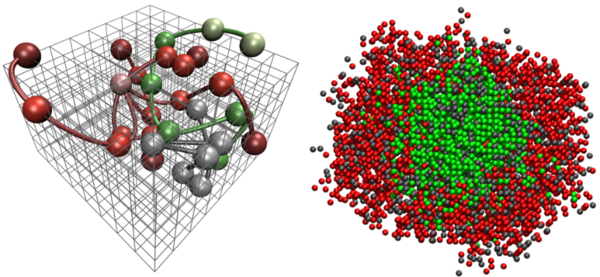Chemical reactions in lattice polymer models
Methods: Statistical physics, monte carlo, lattice simulations
Biomolecular condensates are a newly defined class of organelle in the cell. In contrast to the classical picture of a cellular organelle, there is no membrane separating the inside from outside. Instead, they form through the physics of proteins phase separating into droplets similar to oil demixing from water. One of their primary functions is expected to be as reaction chambers where enzymes and substrates are localized into volumes separated from the rest of the cell. Much of the work incorporating chemical reactions into droplets has been through studying reaction diffusion equations or solving Cahn-Hilliard equations. These techniques are all mean field and could miss important physics that becomes apparent at the polymer scale.
In this project we will build upon a lattice polymer model to develop and incorporate chemical reactions into this framework. Lattice polymer models provide an important intermediate level of coarse-graining which has been used successfully for studying how proteins phase separate. Understanding chemically active systems requires access to systems even larger than what is needed to study the thermodynamics, making lattice polymer models especially important. The larger scale view of where this project fits into is understanding how polymer architecture can impact the chemical reactions. Some examples are: (i) Does the heteropolymer nature that is inherent in proteins enhance droplets’ ability to act as chemical reactors? (ii) Are there cases where caging effects can be beneficial? (iii) What are the limits where reaction-diffusion equations break down?

The key tasks for this project are:
- Add an additional move to the simulation engine that changes one class of bead to different class of bead.
- Characterize how to relate the monte carlo moves to the dynamics of a real system.
- Run simulations with different architectures of polymers to examine how the macroscopic scale reaction rates are impacted.
Keywords: biomolecular condensates, active matter, monte carlo
References:

